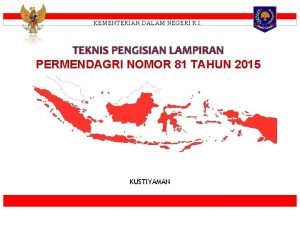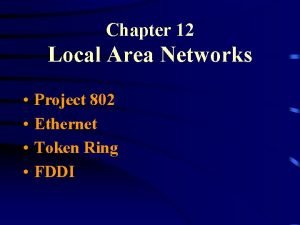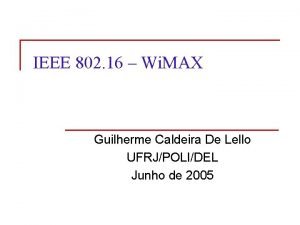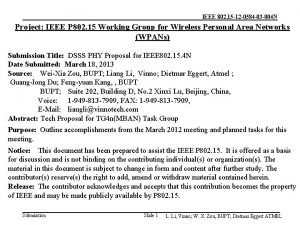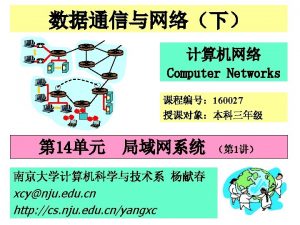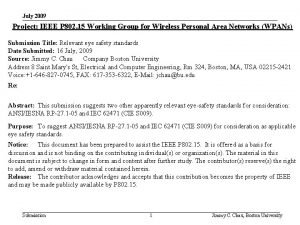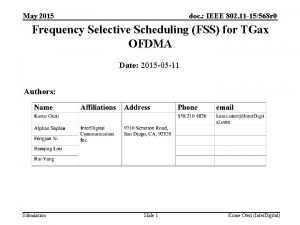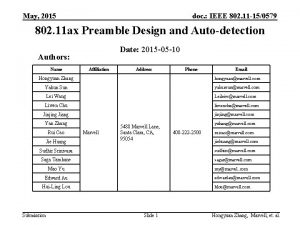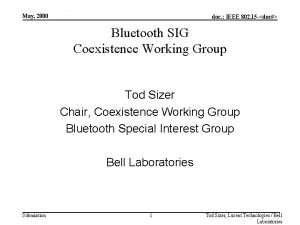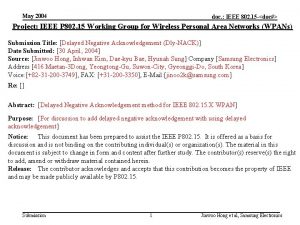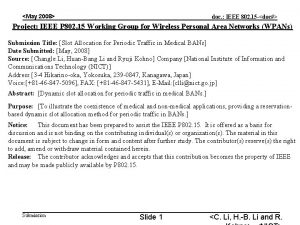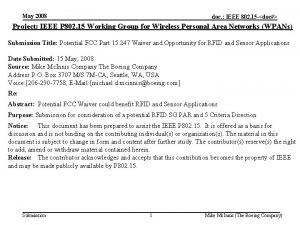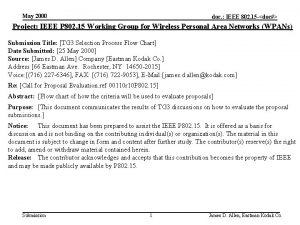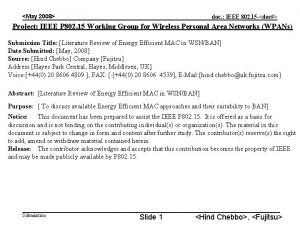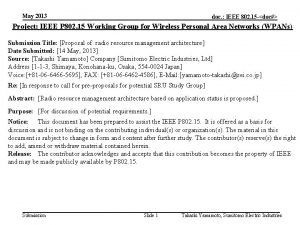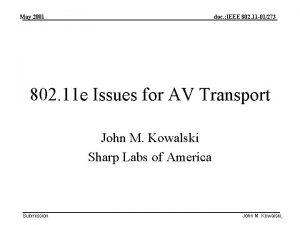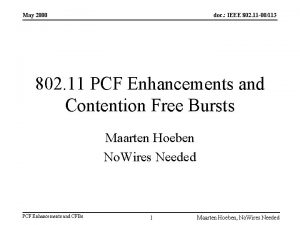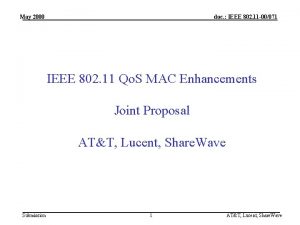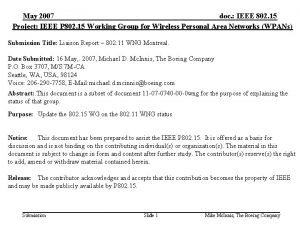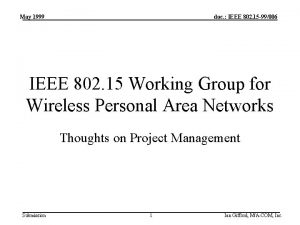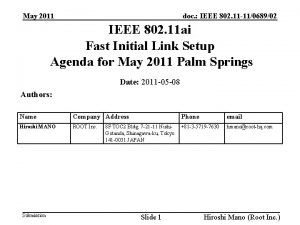May 2015 doc IEEE 802 11 15568 r













![May 2015 doc. : IEEE 802. 11 -15/568 r 0 References [1] IEEE 802. May 2015 doc. : IEEE 802. 11 -15/568 r 0 References [1] IEEE 802.](https://slidetodoc.com/presentation_image_h2/dc158b4ac8a1e716dfea59e1bef7a588/image-14.jpg)





- Slides: 19

May 2015 doc. : IEEE 802. 11 -15/568 r 0 Frequency Selective Scheduling (FSS) for TGax OFDMA Date: 2015 -05 -11 Authors: Submission Slide 1 Kome Oteri (Inter. Digital)

May 2015 doc. : IEEE 802. 11 -15/568 r 0 Outline • • Motivation Channel Selectivity and User Allocation Channel Selectivity Simulation Results System Throughput Simulation System Throughput Results Conclusions References Submission Slide 2 Kome Oteri (Inter. Digital)

May 2015 doc. : IEEE 802. 11 -15/568 r 0 Abstract This contribution quantifies the potential resource unit (RU) selection gains for OFDMA transmissions using different RU sizes, over a few TGax channels, in all TGax simulation scenarios. The gains achieved from CSI-based RU selection for TGax OFDMA motivate the need for efficient RUbased feedback. Submission Slide 3 Kome Oteri (Inter. Digital)

May 2015 doc. : IEEE 802. 11 -15/568 r 0 Motivation • The 11 ax specification framework has already defined UL/DL OFDMA as one of the key 11 ax MU features [1]. – OFDMA may exploit the channel selectivity to maximize frequency selective multiplexing gain in dense network conditions [5][6][7]. • We quantify the gains for ideal resource unit (RU) selection for OFDMA transmissions – over different TGax channels [2][3] – in different TGax simulation scenarios [8] – using different RU sizes Submission Slide 4 Kome Oteri (Inter. Digital)

May 2015 doc. : IEEE 802. 11 -15/568 r 0 Channel Selectivity and User Allocation • OFDMA could be used to exploit the channel selectivity in the channel: – In one channel instance (using Channel D model [2]), the maximum gain between best RU and worst RU is as high as 9 d. B. • With CSI at the transmitter, it can allocate only the “best” sub-channel to a STA and avoid allocating the worst sub-channel to that user – this may require sounding or signaling between transmitter and receivers Submission Slide 5 Kome Oteri (Inter. Digital)

May 2015 doc. : IEEE 802. 11 -15/568 r 0 Simulation Methodology and Assumptions § Simulation Methodology: • Characterize difference between best and worst user allocation (Instantaneous loss) • Max_min delta (d. B) = Channel power (best RU) – Channel power (worst RU). • Characterize the difference between a best and a random user allocation (Average loss) • Ave_delta (d. B) = Channel Power (best RU) – Channel power(Averaged) § Simulation Assumptions: • • 20 MHz Channel-B, Channel-D [2], and UMi channel [3] Statistics based on 10000 channel instances Numerology derived from [4] Submission Slide 6 Kome Oteri (Inter. Digital)

May 2015 doc. : IEEE 802. 11 -15/568 r 0 Exemplary Simulation Results – Channel B – Observations: The smaller the RU size, the more RU selection gain potentially achieved saturation Note: Similar results for Channel D and UMi channel may be found in the additional material section Submission Slide 7 Kome Oteri (Inter. Digital)

May 2015 doc. : IEEE 802. 11 -15/568 r 0 Summary of Channel Gain Analysis • We summarize the gain in RU energy (Ave_delta (d. B)) based on channel selection vs random channel allocation Channel B – Channel D – UMi • Observations: – Gain increases as the RU size decreases – Rate of increase slows as the RU size decreases Submission Slide 8 Kome Oteri (Inter. Digital)

May 2015 doc. : IEEE 802. 11 -15/568 r 0 System Throughput Simulation Assumptions • No MAC protocol overhead assumed • STAs are located based on specific TGax simulation scenarios [8] • Non-continuous resource allocation was allowed 1 2 3 Scenario Name Topology Channel Model Parameter Value Residential A - Apartment building 10 m x 10 m apartments in a multi-floor building 5 STAs per BSS Indoor (B/D) Scheduler 1. Proportional Fair [9] 2. Random Enterprise Indoor Small BSS Hotspot Outdoor Large 4 BSS Hotspot B - Dense small BSSs with clusters 10 m inter AP distance 64 STAs per BSS C - Dense small BSSs, uniform 17. 32 m inter AP distance 30 STAs per BSS D - Large BSSs, uniform 130 m inter AP distance 50 STAs per BSS System Shannon Capacity Throughput based on system SINR Metric Indoor (B/D) Outdoor (Umi) Table derived from [8] Submission Slide 9 RU allocation Non-contiguous RU allocation Case 1: RU 1 Case 2: RU 2 Case 3: RU 5 Case 4: RU 9 Case 5: RU 18 Kome Oteri (Inter. Digital)

May 2015 doc. : IEEE 802. 11 -15/568 r 0 Exemplary Simulation Results : SS 3 PF: Proportional fair [9] Number of stations: 30 Gain of PF scheduling vs Random Scheduling Submission Slide 10 Kome Oteri (Inter. Digital)

May 2015 doc. : IEEE 802. 11 -15/568 r 0 Summary of System Throughput Analysis • Large system throughput gains for scenarios with low baseline throughputs • SS 3: 42% and SS 4: 60% • Behavior correlates to channel selectivity performance observed in previous results • Channel B has large initial performance increase due to multi-user diversity in RU 1 but quickly saturates as the number of RUs increase • Channel D and UMi channel show much less initial increase and saturation Submission Slide 11 Kome Oteri (Inter. Digital)

May 2015 doc. : IEEE 802. 11 -15/568 r 0 Observations – Scheduling for OFDMA transmission provides a gain in the system throughput of 802. 11 ax – The scheduling is easily done at the AP when Channel State Information (CSI) is available. – Currently, 802. 11 provides CSI feedback for [10]: • Fast link adaptation: single MCS feedback sequence identifier for a entire transmission bandwidth • DL MU-MIMO: compressed feedback of channel coefficients for multiple sub-carriers and average SNR of each Space Time Stream – The accuracy of the CSI required for DL/UL OFDMA may be more than that required for fast link adaptation and less than that required for DL MU-MIMO Submission Slide 12 Kome Oteri (Inter. Digital)

May 2015 doc. : IEEE 802. 11 -15/568 r 0 Conclusions • With CSI-based RU selection, OFDMA may maximize the system throughput gain in TGax scenarios. • We quantify the potential resource unit (RU) selection gains for TGax OFDMA transmissions with different RU sizes, for different channels and in different simulation scenarios. – System throughput gains of up to 42% in indoor scenarios and 60% in outdoor scenarios may be seen by using CSI-based RU selection as opposed to a random allocation method. • CSI specific to OFDMA is needed at the transmitter to realize these gains. Submission Slide 13 Kome Oteri (Inter. Digital)
![May 2015 doc IEEE 802 11 15568 r 0 References 1 IEEE 802 May 2015 doc. : IEEE 802. 11 -15/568 r 0 References [1] IEEE 802.](https://slidetodoc.com/presentation_image_h2/dc158b4ac8a1e716dfea59e1bef7a588/image-14.jpg)
May 2015 doc. : IEEE 802. 11 -15/568 r 0 References [1] IEEE 802. 11 -15/132 r 4 Spec Framework, Intel [2] IEEE 802. 11 -03/940 r 4, TGn Channel Models, Broadcom [3] Report ITU-R M. 2135 -1, (12/2009), Guidelines for evaluation of radio interface technologies for IMT-Advanced [4] IEEE 802. 11 -15/330 r 1, OFDMA Numerology and Structure, Intel [5] IEEE 802. 11 -14/858 r 1, Analysis on Multiplexing Schemes exploiting frequency selectivity in WLAN Systems, Samsung [6] IEEE 802. 11 -14/1227 r 2, OFDMA Performance Analysis, Mediatek [7] IEEE 802. 11 -15/383 r 0, Impact of number of sub-channels in OFDMA, Ericsson [8] IEEE 802. 11 -15/980 r 10, Simulation Scenarios, Qualcomm [9] Zhishui Sun; Changchuan Yin; Guangxin Yue, "Reduced-Complexity Proportional Fair Scheduling for OFDMA Systems, “ Proc. IEEE International Conference on Communications, Circuits and Systems (ICCCAS), vol. 2, pp. 1221 -1225, 2006 [10] IEEE P 802. 11 ac™/D 7. 0, Draft STANDARD Part 11: Wireless LAN Medium Access Control (MAC) and Physical Layer (PHY) specifications Amendment 4: Enhancements for Very High Throughput for Operation in Bands below 6 GHz [11] IEEE 802. 11 -14/571 r 8, Evaluation Methodologies, Broadcom Submission Slide 14 Kome Oteri (Inter. Digital)

May 2015 doc. : IEEE 802. 11 -15/568 r 0 Additional Material Submission Slide 15 Kome Oteri (Inter. Digital)

May 2015 doc. : IEEE 802. 11 -15/568 r 0 Simulation Results – Channel D – Observations: Similar to Channel B but with less saturation at 13 tones Submission Slide 16 Kome Oteri (Inter. Digital)

May 2015 doc. : IEEE 802. 11 -15/568 r 0 Simulation Results – Channel UMi – Observations: Even less saturation as number of RUs reduce Submission Slide 17 Kome Oteri (Inter. Digital)

May 2015 doc. : IEEE 802. 11 -15/568 r 0 System Throughput Performance for SS 1 -4 SS 1 SS 2 SS 4 SS 3 Submission Slide 18 Kome Oteri (Inter. Digital)

May 2015 doc. : IEEE 802. 11 -15/568 r 0 Simulation Methodology of System Throughput • Obtain per tone SINR of STAs based on path loss, shadowing of specific simulation scenario and fading channel • Estimate effective SINR of sub-channels based on the specific numerology using the capacity mapping in [11] • Perform proportional fair scheduling based on effective SINR of different sub-channels [9] • Assign users to sub-channels • Estimate PHY layer system throughput based on capacity of chosen users • Average over multiple drops Submission Slide 19 Kome Oteri (Inter. Digital)
 Bridges from 802.x to 802.y
Bridges from 802.x to 802.y Bridges from 802.x to 802.y
Bridges from 802.x to 802.y Ieee 802
Ieee 802 Ieee 802 family
Ieee 802 family Ieee 802 3 compliance
Ieee 802 3 compliance Wlan standards
Wlan standards Arquitetura ieee 802
Arquitetura ieee 802 Norma ieee 802
Norma ieee 802 Ieee 802 standard
Ieee 802 standard Ieee 802 bluetooth
Ieee 802 bluetooth 802 ieee
802 ieee Lampiran 3 permendagri no. 81 tahun 2015 doc
Lampiran 3 permendagri no. 81 tahun 2015 doc Hci design patterns
Hci design patterns Project 802
Project 802 802 family
802 family 802 16
802 16 802 15
802 15 802 protocols
802 protocols Sybex ccna
Sybex ccna 09 802 0561
09 802 0561











